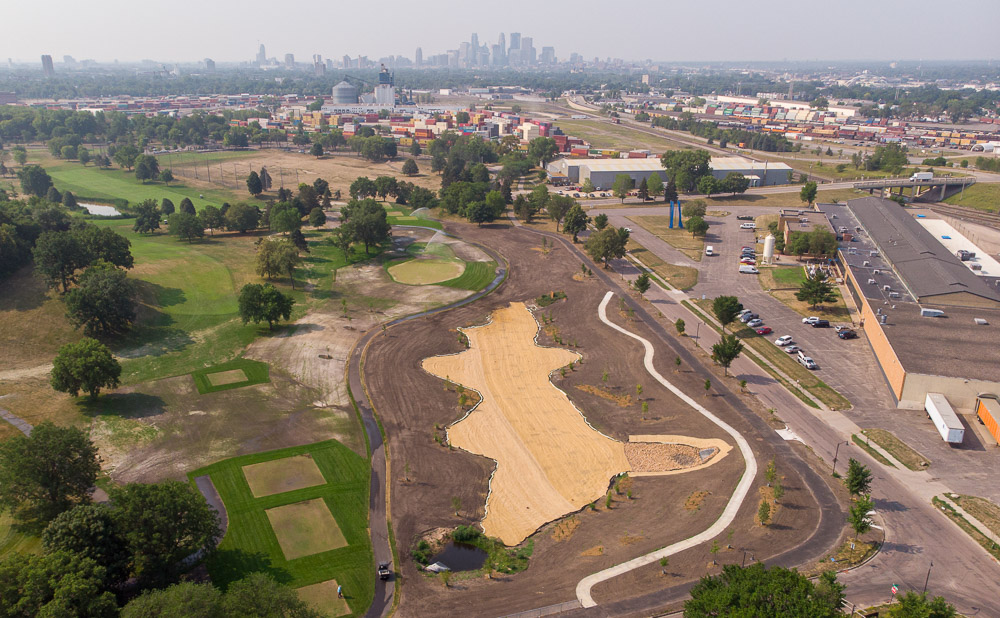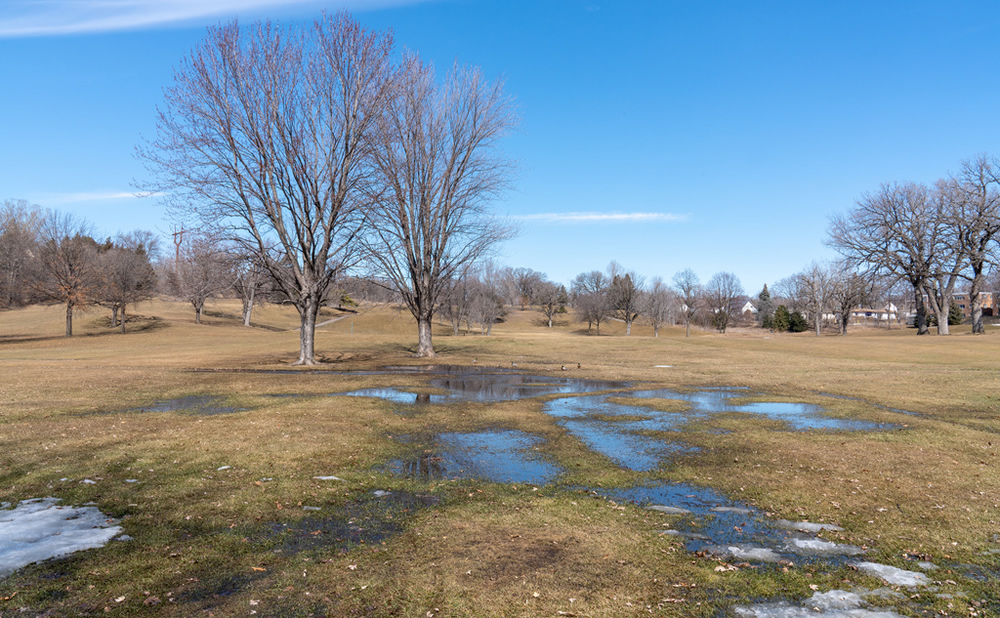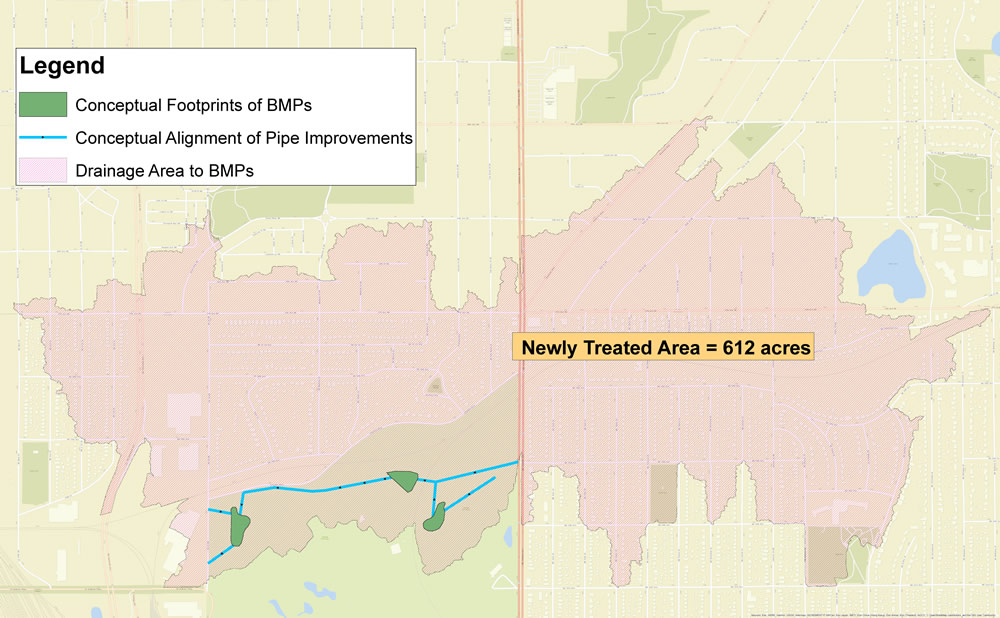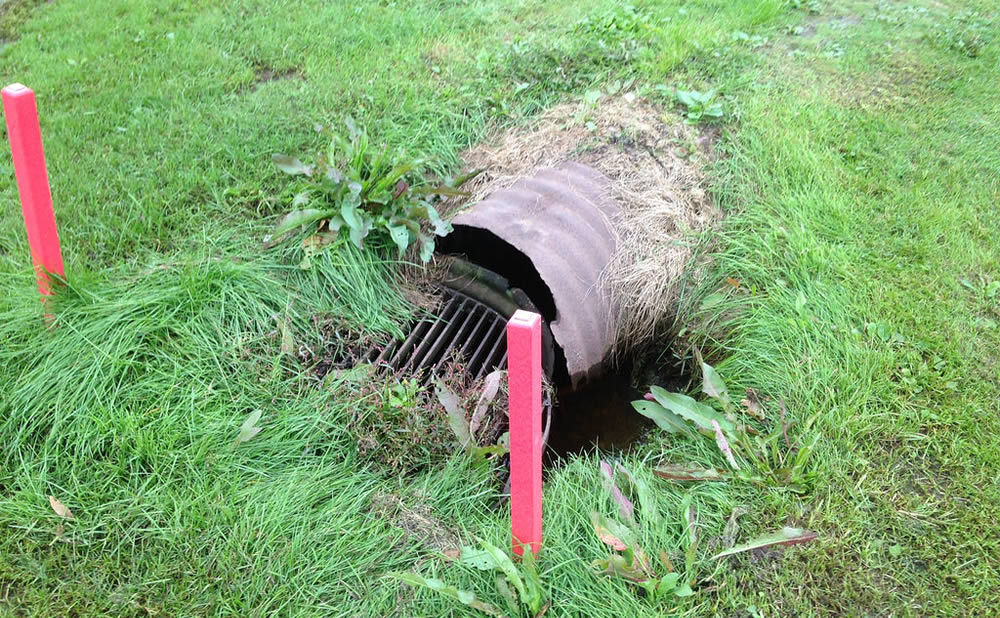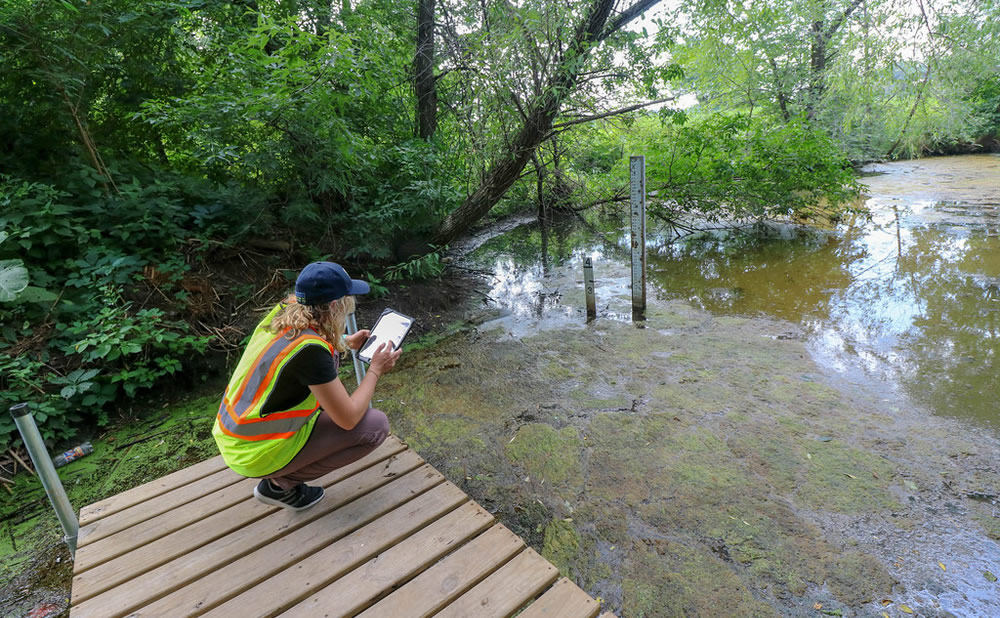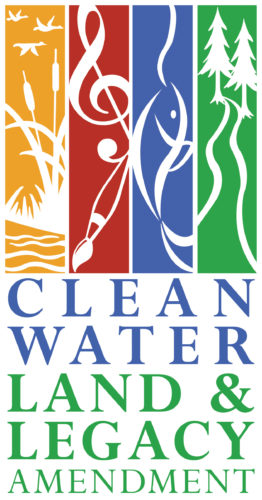Northern Columbia Green Infrastructure
Green infrastructure at the Columbia Golf Course and Park will protect water quality, reduce flooding, and improve habitat.
Overview
Project Details
City: Minneapolis
Type: Capital Improvement Project
Status: Active
Timeline: 2019-2023
MWMO Funding: Not to exceed $3,571,789 for construction, plus not to exceed $644,799 for construction services (bidding, construction oversight, and administration)
Partner Funding: City of Minneapolis funds not to exceed $2,908,012; Board of Water and Soil Resources (Clean Water Fund) grant of $800,000; and Hennepin County Grant of $100,000 to support construction costs
Partners: Board of Water and Soil Resources; City of Minneapolis; Hennepin County; Minneapolis Park and Recreation Board
Contractors and Consultants: Minger Construction Companies, Inc. (subcontractors include Duininck Inc., Haugo Geotechnical Services, Husky Construction, Inc., and Landbridge Ecological); Norby Golf Course Design; SRF Consulting (subconsultants include Applied Ecological Services, Braun Intertec Corporation, and CNA Consulting Engineers)
Related:
Northeast Stormwater Management Initiative
Hoyer Heights Tree Trenches
Columbia Stormwater Pretreatment
Nancy Stowe
Projects and Outreach Director
612-746-4978
Email Nancy Stowe
View Bio
Project Documents
The MWMO and its partners constructed stormsewer improvements and green stormwater infrastructure (GSI) at the Columbia Golf Course and Columbia Park in Northeast Minneapolis. These GSI features will treat polluted runoff from 813 acres — 75 percent of which is currently receiving no water quality treatment. In addition to keeping pollutants out of the nearby Mississippi River, the project will reduce flooding in nearby neighborhoods and the golf course itself, improve habitat, and enhance golf play and other recreational opportunities.
Background
Localized flooding is a challenge for many neighborhoods in the area, and the Columbia Golf Course itself suffered from frequent flooding and drainage problems. A low spot on the landscape, Columbia Golf Course once contained historic Lake Sandy and remains a natural spot for water to accumulate. An aging stormsewer draining the northern half of the golf course and park was in poor and failing condition.
The MWMO, the City of Minneapolis, and the Minneapolis Park and Recreation Board (MPRB) launched a joint effort called the Northeast Stormwater Management Initiative to address these issues as well as related problems in the surrounding watershed (known as the “1NE Watershed”). The initiative is designed to mitigate flooding, treat polluted runoff, and improve urban wildlife habitat in this 2,150-acre area. The Northern Columbia Green Infrastructure project is among the first to result from the initiative; additional improvements to the golf course and within the surrounding neighborhoods will be phased in over time.
Stormwater and Habitat Improvements
The green stormwater infrastructure and habitat improvements at the Columbia Golf Course and Park are intended to work together as a system to capture and clean runoff and provide ecological benefits. They are connected via underground stormsewer pipes that convey runoff from the golf course and the adjacent neighborhoods to the various GSI features.
Elements of this system include:
- Stormwater Pretreatment Units — Pretreatment units on the east and west sides of the golf course help separate and trap trash, debris, sediment, and hydrocarbons from stormwater runoff arriving from upstream neighborhoods prior to it being routed to the wet pond and stormwater basins (see the figure below).
- New Trunk Stormsewer — A reconstructed main stormsewer line will convey stormwater from Central Avenue across the golf course and park. The larger stormpipe will improve drainage and reduce flooding in the upstream neighborhoods and in the golf course. (The connections from the upstream neighborhoods are expected to be made after the vegetation in the basins has become established so that high flows do not drown new plants.)
- Reconstructed Wet Pond — The pond in the northeast portion of the golf course has been enlarged to provide rate control, reduce flooding on the golf course, and provide improved water quality treatment before the runoff is routed to the Multi-Use Field Basin. The pond has a combination of permanent pool storage and extended detention storage above the permanent pool.
- Multi-Use Field Basin — A new stormwater basin in Columbia Park near the multi-use athletic field provides additional stormwater treatment and rate control. It is designed to temporarily hold stormwater, allow the pollutants to settle out through sedimentation, and slowly release it to the stormsewer pipe leading to the Northwest Basin.
- Northwest Basin — A new stormwater basin in the northwest corner of the golf course will capture and treat runoff both from the neighborhoods to the north as well as from the golf course and park areas to the east. It is designed to function as an ecologically enhanced stormwater pond, maximizing habitat while capturing and treating stormwater pollutants.
- Habitat Restoration — Native seeding and plantings will create or improve 19 acres of habitat, which includes oak savanna, prairie, woodlands, and the footprint of the stormwater features. Plant mixes include trees, shrubs, and a diversity of sedges, grasses, and wildflowers. Invasive woody and herbaceous species such as buckthorn and garlic mustard were removed or controlled prior to seeding in fall 2021.
The graphic below depicts the flow of stormwater runoff through the project site and also shows the habitat restoration areas.
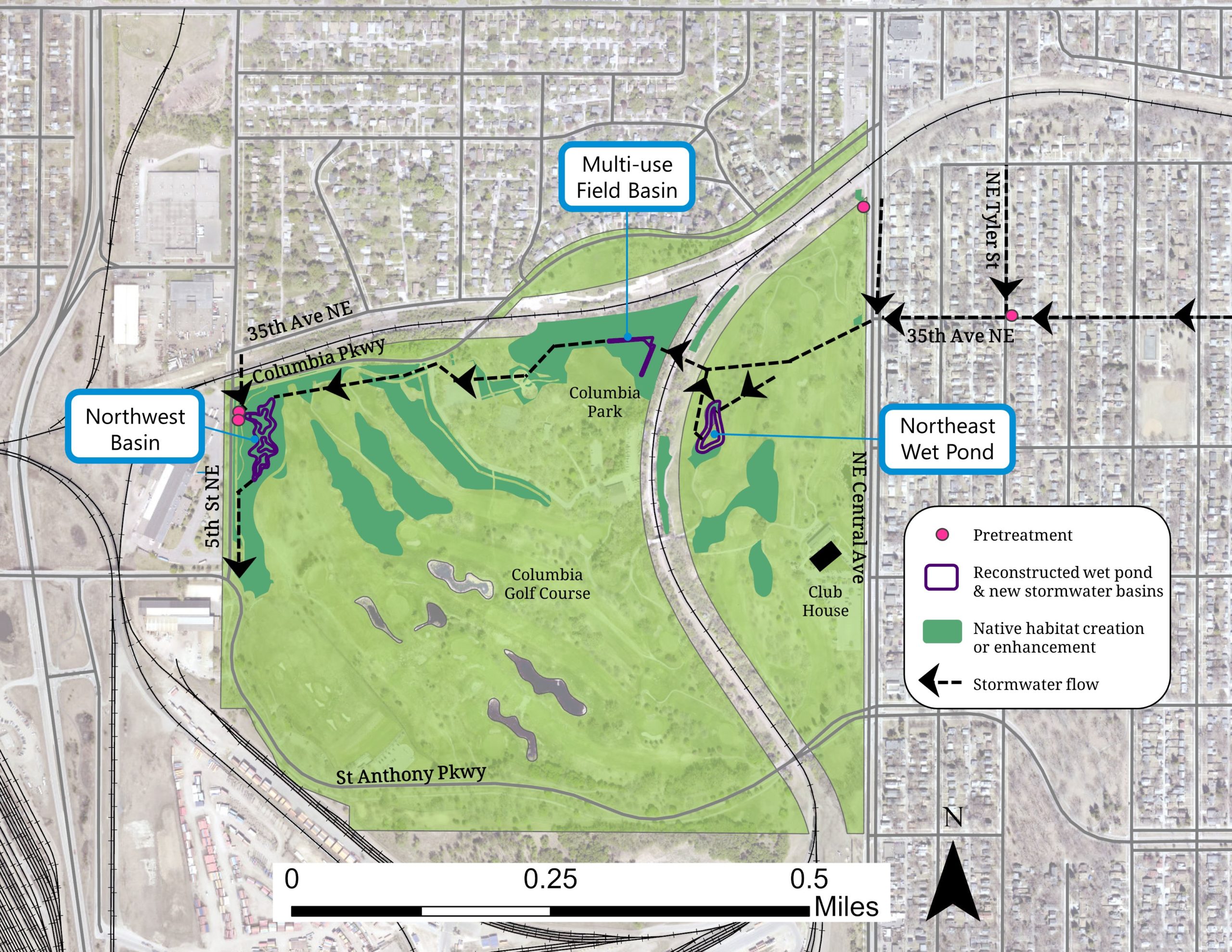
When the project becomes fully operational, these systems will capture an estimated 37 tons of sediment and 170 pounds of phosphorus each year, keeping these pollutants out of the river.
Golf Improvements
Improvements to the golf course were funded by MPRB and include a new layout of Hole 14, raised tee boxes on Hole 15 (now hole 6), a new cart path, a new back tee, and improved fairway on Hole 7 (now hole 16), and improved fairway on Hole 2. The course will retain the same number of holes and strokes. Norby Golf Course Design provided input to help improve playability of the course.
Funding
Prior to construction, the MWMO and its project partners dedicated significant staff time and funds towards developing this initiative. Construction of the project by Minger Construction, Inc., and its subcontractors is estimated to cost up to $7.4 million. Of this total, $2.9 million will be reimbursed by the City of Minneapolis, $800,000 will be reimbursed through a Minnesota Board of Water and Soil Resources (BWSR) grant (via the state’s Clean Water, Land and Legacy Amendment), and $100,000 will be reimbursed through a Hennepin County Natural Resources Opportunity Grant. The anticipated construction contribution of MWMO funds to complete this project is $3.6 million. The amenities will be on MPRB land. Allocated staff time from all partner agencies includes planning, design review, community engagement and project updates, and construction oversight. Construction oversight by SRF Consulting and its subcontractors is set at a not-to-exceed amount of $644,799.
Project Timeline and Impacts
Planning and preliminary design of the project began in 2017, with final design starting in 2019. Construction of the golf course improvements began on October 26, 2020. Phase 1 of the project (October 2020–February 2021) included removal/abandonment of the old stormsewer, construction of the new stormsewer, tunneling under the Canadian Pacific Railway, earthwork, and mass grading. Phase 2 of the project (April 2021–December 2021) included final grading, park and golf course restoration, and native seeding for permanent restoration. The MWMO is paying the costs associated with the ecological restoration components of the project, including up to four years of specialized vegetation establishment and maintenance activities.
Current Status
In the spring and summer of 2023, the MWMO and its partners will continue to make adjustments to the stormwater basins so that the systems can become fully operational. Residents and visitors can expect to see changes in vegetation and fluctuating water levels in the basins as contractors work to improve the functioning of the systems.
Construction of city stormsewer connections to direct additional stormwater runoff from the surrounding neighborhoods into the project area is anticipated in fall 2023 for Central Avenue and as early as 2024 for 5th Street NE. A new diversion manhole (DMH) will be constructed along the trail at Central Avenue NE to redirect a portion of the stormwater through the golf course and park. This will help reduce the potential for flooding in the area.
Stormsewer improvements are also planned in the neighborhood northwest of the golf course in the future to reduce flooding there too. The new trunk will drain, in part, into the Northwest Basin through another DMH to be constructed at 5th Street NE.
More information can be found at mwmo.org/northeast. To sign up to receive email updates on this project, click here.
